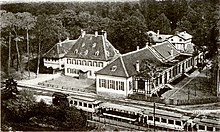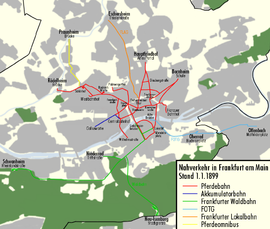Frankfurt Forest Railway
| Frankfurt Forest Railway | |||||||||||||||||||||||||||||||||||||||||||||||||||||||||||||||||||||||||||||||||||||||||||||||||||||||||||||||||||||
|---|---|---|---|---|---|---|---|---|---|---|---|---|---|---|---|---|---|---|---|---|---|---|---|---|---|---|---|---|---|---|---|---|---|---|---|---|---|---|---|---|---|---|---|---|---|---|---|---|---|---|---|---|---|---|---|---|---|---|---|---|---|---|---|---|---|---|---|---|---|---|---|---|---|---|---|---|---|---|---|---|---|---|---|---|---|---|---|---|---|---|---|---|---|---|---|---|---|---|---|---|---|---|---|---|---|---|---|---|---|---|---|---|---|---|---|---|---|
|
The final stop in Neu-Isenburg when
the forest railway opened on February 4, 1889 | |||||||||||||||||||||||||||||||||||||||||||||||||||||||||||||||||||||||||||||||||||||||||||||||||||||||||||||||||||||
|
Route network of the Waldbahn 1899 (green)
| |||||||||||||||||||||||||||||||||||||||||||||||||||||||||||||||||||||||||||||||||||||||||||||||||||||||||||||||||||||
| Route length: | 20.2 km | ||||||||||||||||||||||||||||||||||||||||||||||||||||||||||||||||||||||||||||||||||||||||||||||||||||||||||||||||||||
| Gauge : | 1435 mm ( standard gauge ) | ||||||||||||||||||||||||||||||||||||||||||||||||||||||||||||||||||||||||||||||||||||||||||||||||||||||||||||||||||||
| Dual track : | Textorstraße, Schweizer Straße, Mörfelder Landstraße to Ziegelhüttenweg |
||||||||||||||||||||||||||||||||||||||||||||||||||||||||||||||||||||||||||||||||||||||||||||||||||||||||||||||||||||
| Route from Sachsenhausen to Niederrad / Schwanheim | |||||||||||||||||||||||||||||||||||||||||||||||||||||||||||||||||||||||||||||||||||||||||||||||||||||||||||||||||||||
|
|||||||||||||||||||||||||||||||||||||||||||||||||||||||||||||||||||||||||||||||||||||||||||||||||||||||||||||||||||||
| Route to Neu-Isenburg | |||||||||||||||||||||||||||||||||||||||||||||||||||||||||||||||||||||||||||||||||||||||||||||||||||||||||||||||||||||
|
|||||||||||||||||||||||||||||||||||||||||||||||||||||||||||||||||||||||||||||||||||||||||||||||||||||||||||||||||||||
The Frankfurter Waldbahn was a standard gauge steam tram in Frankfurt am Main that operated from 1889 to 1929. In 1899, the city of Frankfurt am Main took over the Waldbahn and gradually integrated the routes into the Frankfurt am Main electric tram . The last steam-powered train ran on October 5, 1929. The station buildings and car halls in Neu-Isenburg and Frankfurt-Schwanheim are still preserved from the Waldbahn facilities . The two branches of the route are now used by lines 12 and 17. The former forest railway line between Riedhof and Oberforsthaus served until 2013 during the folk festival for the Wäldchestag for the Lieschen reinforcement line .
business
The two final stops in Frankfurt were at Untermainbrücke and Offenbach train station in Frankfurt-Sachsenhausen . The two branches of the route met at the intersection of Schweizer Straße and Textorstraße and followed Schweizer Straße to the south, crossed under the Bebraer Bahn at the Bebraer train station and turned into Mörfelder Landstraße, which leads to the west . The 9.6-kilometer main route led over the Oberforsthaus to Schwanheim , with branches at Riedhof to Neu-Isenburg (6.4 kilometers) and on the Niederräder Landstrasse to Niederrad (4.2 kilometers). The entire network length of the Frankfurt Forest Railway was 20.2 kilometers. The sections of the route on Textorstrasse and Schweizer Strasse to the Ziegelhüttenweg station on Mörfelder Landstrasse were double-track with a road surface , while the external routes leading mainly on country roads and through the Frankfurt city forest were single-track and predominantly with a special rail body, with diversions at the stops.
The main depot with workshops was located on Textorstrasse, with further car halls near the terminal stops in Neu-Isenburg, Niederrad and Schwanheim.
All steam locomotives of the Waldbahn were designed as two-axle, clad tram locomotives with a revolving platform. They were fired with coke to limit smoke pollution. In 1895 the company had nine locomotives. In 1908 the three locomotives of the Frankfurt-Eschersheimer local railway were added. The passenger trains initially consisted of three, later up to five passenger cars with open platforms and two bogies . Each of the 44 passenger cars had 40 seats and up to 18 standing places on the open platforms. Open summer cars were also used in the warm season . The forest railway was heavily used for excursions, especially on Sundays and public holidays. Especially on the Neu-Isenburg line, the trains often ran with seven cars in the summer because of the high demand, although the supervisory authority actually only allowed five.
According to the summer schedule of 1912, trains ran between Sachsenhausen and Neu-Isenburg on weekdays between 5:53 a.m. and 11:00 p.m. from Sachsenhausen, in the opposite direction between 5:18 a.m. and 10:25 p.m. On Sundays the first train in Neu-Isenburg did not leave until 6:22 a.m., from Sachsenhausen at 6:47 a.m. The trains ran between Sachsenhausen and Schwanheim on weekdays from 6:22 a.m. to 10:00 p.m., in the opposite direction from 5:45 a.m. to 9:15 p.m. On Sundays the first train left Schwanheim at 7:02 a.m. and from Sachsenhausen at 7:50 a.m. The train sequence of one or two trains per hour was significantly less than today. The maximum speed was 30 kilometers per hour on its own railway track, on Chausséen and on 15 roads. In Textorstraße and at other dangerous spots in the area of localities, people were only allowed to drive so fast "that an officer with a signal flag and bell can walk in front of the train".
Freight traffic was of considerable importance, especially for the transport of gravel and sand from the pits near Goldstein to Sachsenhausen. Freight trains mainly ran at night so as not to hinder passenger traffic on the single-track routes. At Frankfurt-Louisa station there was a connection with the Main-Neckar Railway . A siding also led from the Oberforsthaus to the Goldstein station on the Mainbahn . The Waldbahn owned a total of 34 freight cars.
After the city took over the forest railway, the route network was gradually reduced with the expansion of the electric tram service. First, on February 29, 1908, the line from the Niederräder Landstrasse branch to Niederrad was closed. From November 1, 1920, the trains from Neu-Isenburg and Schwanheim ended at Ziegelhüttenplatz, where a third track was installed to move the locomotives. The depot in Textorstrasse was no longer used as a parking facility for the forest railway since 1926/27, but for buses and other motor vehicles in the city. The workshop retained its function on both routes until steam operations were discontinued in 1929.
history

On September 6, 1887, the Localbahn-Bau und Betriebs-Gesellschaft Wilhelm Hostmann & Cie. from Hanover the 35-year permit from the Prussian government district of Wiesbaden to build and operate a steam train from Sachsenhausen to Schwanheim, with a branch to Niederrad and Neu-Isenburg. The planned extension of the line to Hessian territory through Neu-Isenburg via Sprendlingen , Dreieichenhain , Götzenhain to Dietzenbach failed due to the resistance of the Hessian Ludwig Railway . The railway to Neu-Isenburg opened on February 5, 1889, and the branch to Schwanheim followed on April 18, 1889.
On February 13, 1890, the company was renamed the Frankfurter Waldbahn-Gesellschaft . During the International Electrotechnical Exhibition in 1891 , a two-axle accumulator railcar operated on the route. The small vehicle commuted between Sachsenhausen and the Oberforsthaus four times a day during the trial. It came from the Hildburghausen-Heldburger Eisenbahn to Frankfurt, which was also operated by Hostmann & Cie. was operated, and had been specially converted from the meter gauge.
At the beginning of 1899 the city of Frankfurt took over the private company for two million marks . The forest railway remained a separate branch of operation from the city tram with its own management, staff, uniforms and tariffs. It was now licensed as a small railway under the Prussian Small Railway Act of July 28, 1892. Only after the incorporation of Niederrad on July 1, 1900 and Schwanheim on January 1, 1928, the electric tram routes were gradually extended to the new parts of the city and the forest railway routes integrated.
First, on August 7, 1907, tram line 15 was extended from Sandhofschleife via the Sachsenhausen municipal hospital to Triftstrasse in Niederrad. The volume of traffic on the Niederräder branch of the Waldbahn then fell significantly, as the new route was shorter and transported passengers directly to the city center. On February 29, 1908, the forest railway therefore stopped operating to Niederrad.
The First World War , the subsequent inflationary period and the French occupation of the western Frankfurt suburbs, which lasted until 1924, prevented further changes . From November 1, 1920, both forest railway lines in Sachsenhausen ended at Ziegelhüttenplatz; the tracks in Schweizer Strasse and Textorstrasse had been shared with the city tram since 1903. From November 1922 to June 1923, the forest railway to Neu-Isenburg was completely shut down due to a lack of coal, and operations to Schwanheim even between September 1922 and November 1924.
It was not until April 10, 1925, that tram line 15 was extended from Niederrad via Oberforsthaus to the new Frankfurt Waldstadion . Since then, the forest railway trains only commuted between Oberforsthaus and Schwanheim. The section between Riedhof and Oberforsthaus has only served as an operating line since then. In 1928/29 the remaining forest railway lines were double-tracked and electrified. On July 13, 1929, the steam service to Schwanheim ended, the next day tram line 21 took over the service between the main station and Schwanheim. The last steam train to Neu-Isenburg ran on October 5, 1929; it was ceremoniously followed by a line 7 train with the most modern of the G series cars .
Present stock
After the operational change, the locomotives were sold to Poland. Neither piece of the other rolling stock of the former forest railway has survived. After the forest railway depot was demolished in 1959/63, a municipal indoor swimming pool was created at this point, which existed until 2007. The depot in Niederrad was demolished some time after its closure in 1908. The two four-track car halls in Schwanheim now house the Frankfurt am Main Transport Museum . The Neu-Isenburg depot , which also has four tracks, burned down completely in an air raid on December 20, 1943 . It was rebuilt in 1955 and is now used to accommodate old or historic locomotives.
The two station buildings in Neu-Isenburg and Schwanheim are still reminiscent of the Frankfurt Forest Railway. However, they can no longer be used by passengers today. Among other things, they contain toilet facilities for the VGF drivers .
Of the former routes, the sections between Goldstein and Schwanheim and between Mörfelder Landstrasse and Neu-Isenburg still exist today. The section between Oberforsthaus and Goldstein was closed in 1975; the tram was relocated to Adolf-Miersch-Strasse and Lyoner Strasse in order to better connect the Niederrad office district to local public transport. Today tram line 12 runs to Schwanheim, line 17 to Neu-Isenburg.
Until 2013, the former forest railway line in Mörfelder Landstrasse between Stresemannallee and Oberforsthaus was still used as a single-track, electrified operating line. During the folk festival for the Wäldchestag every year, the Lieschen special tram line ran on the otherwise unused track between the Riedhof special station (near the Stresemannallee / Mörfelder Landstraße tram station on line 14) and a makeshift stop just before the regular Oberforsthaus station on line 21.
gallery
The former forest railway line to Neu-Isenburg , today's tram line 17
Station building at the final stop Neu-Isenburg city limits on Darmstädter Landstrasse (2007)
literature
- Dieter Höltge, Günter H. Köhler: Trams and light rail vehicles in Germany . 2nd Edition. 1: Hessen. EK-Verlag , Freiburg 1992, ISBN 3-88255-335-9 .
- Horst Michelke, Claude Jeanmaire: One hundred years of Frankfurt trams: 1872 - 1899 - 1972 = Tramways of Frankfurt am Main (Western Germany) . 1st edition. Villigen AG: Verlag Eisenbahn, book publisher for railway and tramway literature, Brugg / Switzerland 1972, ISBN 3-85649-018-3 .
- Gerd Wolff, Andreas Christopher: German small and private railways . 8 Hesse. EK-Verlag , Freiburg im Breisgau 2004, ISBN 978-3-88255-667-4 .
- Jens-Holger Jensen, Günter Appel, Georg Becker: The Textorstrasse - History & Stories (= Sachsenhausen Closer Considered ). Henrich Editions, Frankfurt am Main 2012, ISBN 978-3-921606-91-9 .
- Otto Schmitt: The origin of the forest railway . In: Landschaft Dreieich / Blätter für Heimatforschung, No. 35, February 1939, pp. 137–140.
Web links
Individual evidence
- ↑ a b Municipal Forest Railway Frankfurt (Main) , timetable 1912
- ^ Anton Wiedenbauer, Hans-Jürgen Hoyer: Ride into the future - The history of the Frankfurt tram . Waldemar Kramer Verlag , Frankfurt am Main 1968, p. 95-102 .
- ↑ Lieschen quietly says goodbye ( Memento from April 15, 2014 in the Internet Archive )









